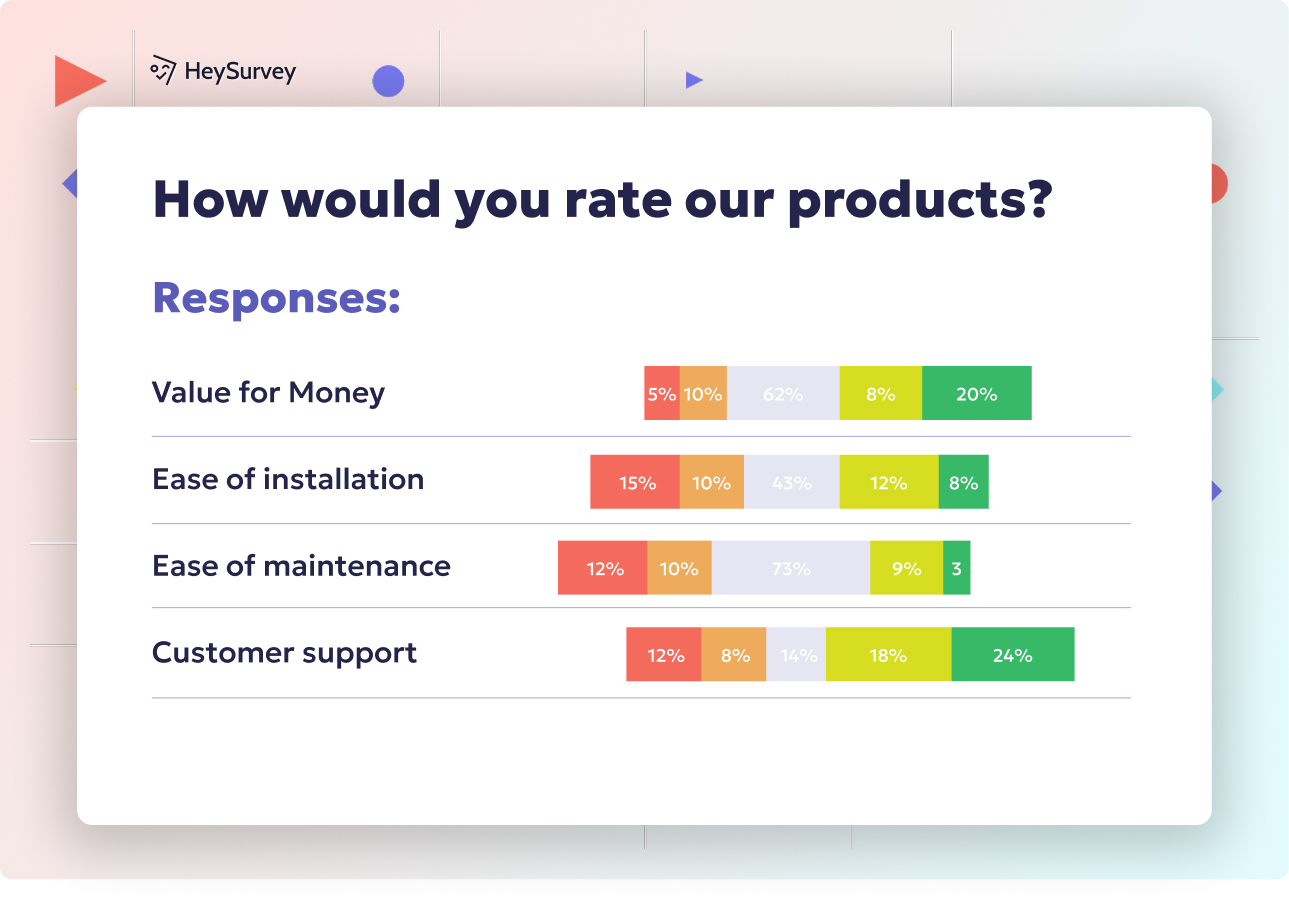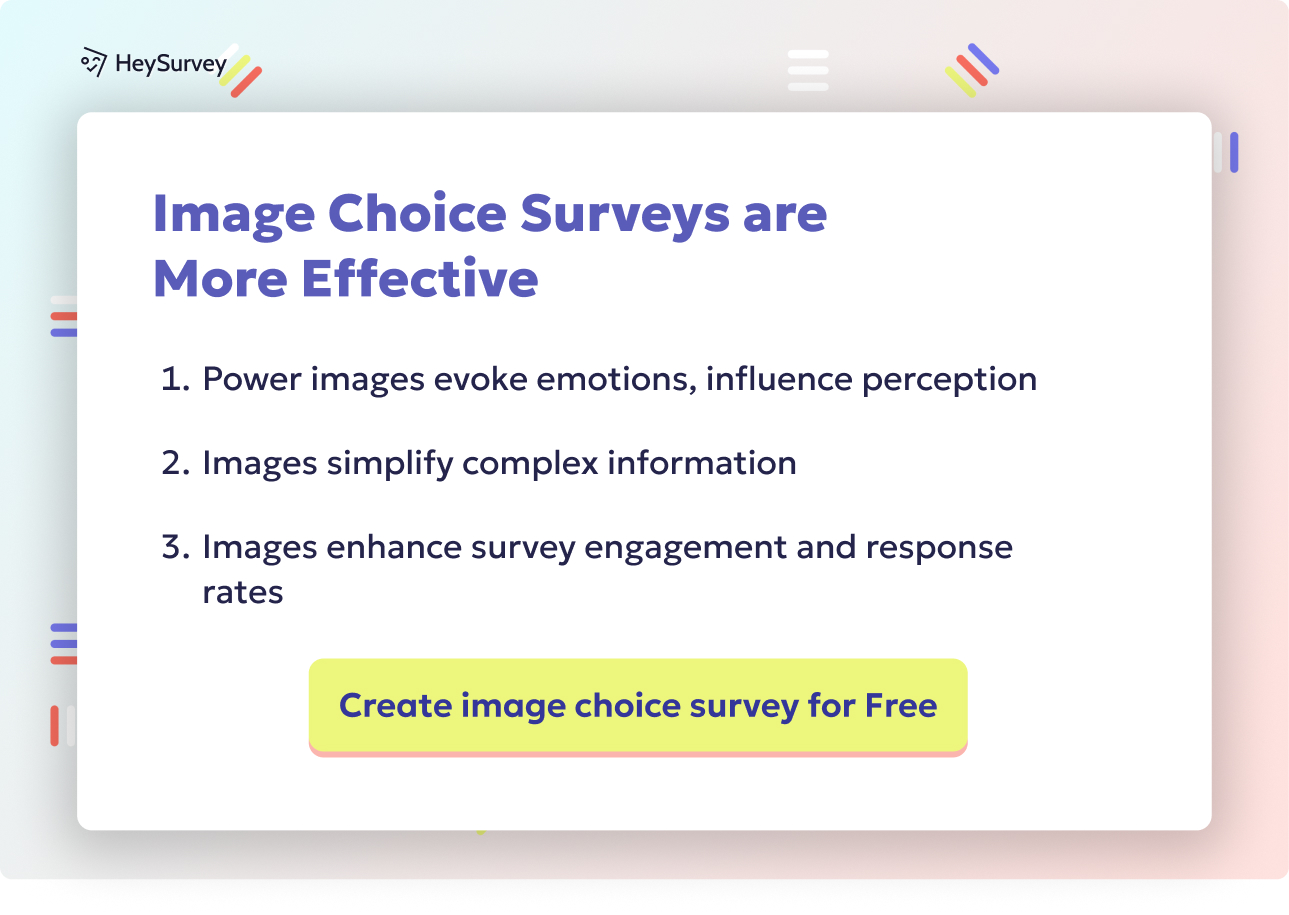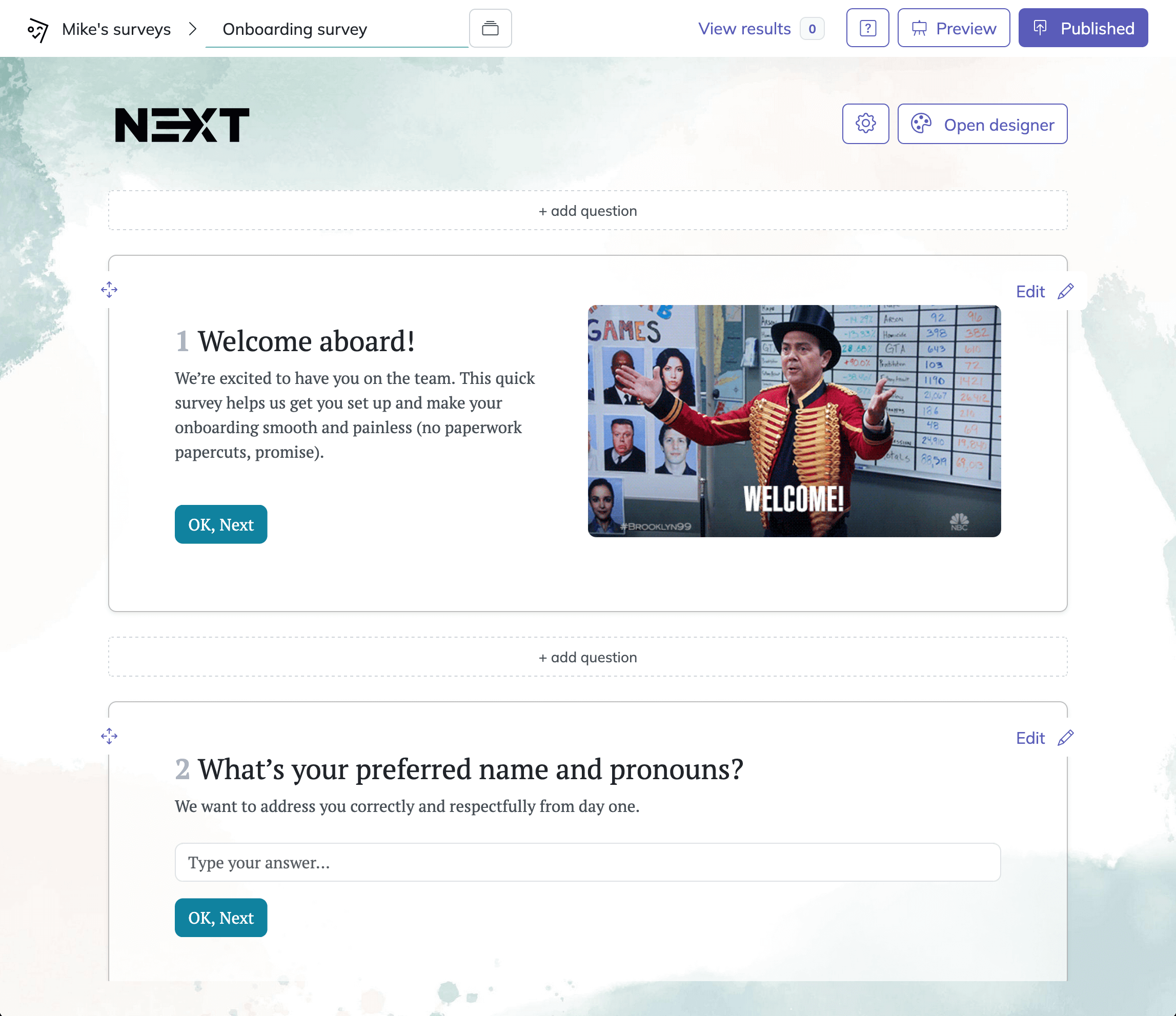29 Gender Equality Survey Questions to Drive Real Change
Explore 30 insightful gender equality survey questions across workplace, education, marketing, and more to advance equity and inclusion.
Gender parity is not just a buzzword—it’s a movement. Whether in an organization, school, or community, insight starts with great questions. Gender-equality surveys do more than collect data; they spark meaningful shifts in diversity metrics, highlight gaps in an inclusive workplace, and fuel positive change. Whether you need a specialized poll or just a few smart questions, the right survey design helps you turn values into actions. Get ready to dive into workplace, academic, public, consumer, and household survey types designed to advance gender equity everywhere.
Workplace Gender Equality Survey
Measuring Equity and Inclusion at Work
The heartbeat of an inclusive workplace is fair opportunity—but how do you measure it? A workplace gender equality survey shines a spotlight on pay equity, promotion rates, leadership representation, and the daily experience of employees. These surveys unravel the subtleties of gender bias, giving companies the data they need to close gaps and celebrate wins.
Ideal for annual DEI audits or when preparing ESG reports, this survey is also essential after big changes like mergers or leadership shifts. Use it to catch emerging trends in workplace equity and to inform robust HR policy decisions. With strong metrics in hand, teams move from subjective guessing to focused action.
Some conversation-starters can open up deeper insights, such as:
On a scale of 1–10, how fairly do you feel promotion opportunities are distributed across genders at our organization?
Have you experienced or witnessed gender-biased comments or actions in the last six months?
Do you believe men and women doing similar work here receive equal pay?
How comfortable do you feel reporting gender-related concerns to HR?
Which workplace benefits would most improve gender equality (e.g., parental leave, flexible hours)?
Each question above targets an aspect of equity: advancement, culture, compensation, safety, and benefits. Seeing clear responses to these “gender bias assessment” topics arms leadership with an actionable blueprint.
Survey best practices in this space include:
- Keeping language neutral (“all genders,” not just men or women)
- Allowing for anonymous responses to encourage honesty
- Checking that response choices cover nonbinary and gender-diverse options
When deployed regularly, these surveys build trust and demonstrate a company’s serious commitment to “workplace equity.” Employees see they’re being heard and can trust in lasting improvements.
A 2017 study found that female students are not disadvantaged by multiple-choice questions, challenging previous claims of gender bias in such formats. (arxiv.org)

Creating a gender equality survey with HeySurvey is easy and fun, even if you’ve never used the platform before. Here’s a quick guide to get you started in just three simple steps—with a couple of bonus tips to make your survey shine!
Step 1: Create a New Survey
First, jump onto HeySurvey and click the button to start a new survey. You can choose from:
- A blank survey if you want to build everything from scratch, or
- A ready-made template to save time and get inspired.
Give your survey a clear name (like “Workplace Gender Equality Checkup”) so you can find it easily later. That’s it—you’re now in the Survey Editor, the control center where the magic happens!
Step 2: Add Your Questions
Next, hit Add Question at the top or wherever you want the new question to appear. HeySurvey offers tons of question types—perfect for crafting questions on gender parity and inclusion. For example:
- Use Scale questions for rating fairness or comfort levels.
- Choose Choice questions for yes/no or multiple-select answers.
- Add Text questions when you want open feedback.
Type your question text, add descriptions if needed, and set questions as required to ensure responses. Feel free to sprinkle images or logos to keep things engaging! You can also organize questions by dragging them up or down—easy breezy.
Step 3: Publish Your Survey
When your questions are polished and ready, click Preview to see your survey as respondents will. Want to tweak colors or fonts? Use the Designer Sidebar to brand your survey with your company logo and style.
Once happy, hit Publish. You’ll get a shareable link to send out or embed on your website. Remember: publishing requires a free account, so if you don’t have one, HeySurvey will prompt you to create it.
Bonus Step: Apply Branding
Make your survey feel official and inviting by uploading your logo to the top left and customizing colors and fonts in the Designer Sidebar. A consistent look builds trust and shows you mean business on gender equality.
Bonus Step: Define Survey Settings
Set survey start and end dates to control when participants can respond. Limit the number of responses if you want to cap participation. You can also add a custom URL redirect so respondents land on a thank-you page or your website after finishing.
Bonus Step: Create Branching Logic
Want to tailor questions based on earlier answers? Use HeySurvey’s branching feature to direct respondents to specific questions depending on their choices. For example, if someone says they’ve experienced gender bias, you might follow up with more detailed questions. This keeps your survey relevant and respectful of respondents’ experiences.
Now you’re ready to explore the HeySurvey template for gender equality surveys by clicking the button below. Start asking meaningful questions today and take your first step toward a more inclusive tomorrow!
Educational Institution Gender Equality Survey
Ensuring Fairness in Schools and Universities
From classroom participation to STEM club lead roles, gender equity in education forms the foundation for talent and leadership in every sector. That’s why robust campus climate surveys are essentials—not just for crisis response, but as a keystone of effective policymaking and accreditation.
Educational institutions use these surveys to spot barriers, celebrate diversity, and fuel meaningful improvements. Deploy them when launching new academic programs, during school climate reviews, or as part of yearly check-ins. They help leadership compare how gender inclusion evolves over time, both in the classroom and beyond.
These questions cut to the heart of educational equity:
Do students of all genders receive equal encouragement to pursue STEM subjects?
Have you observed gender bias in classroom participation or grading?
Rate the fairness of athletic funding and resources among boys’, girls’, and mixed teams.
How safe do students feel reporting gender-based harassment on campus?
Which policy change would most improve gender equality at this institution?
Each question is thoughtfully crafted to surface hidden disparities. Whether it’s the confidence to speak up in math class, equity on sports fields, or safety in housing, these metrics help schools home in on inclusive learning environments.
Boost survey effectiveness with these tips:
- Use inclusive wording (“students of all genders” versus “boys and girls”)
- Provide reporting channels for anonymous feedback
- Invite respondents to suggest new club or curriculum ideas
By rethinking “gender equity in education,” campuses can transform their culture. When everyone feels seen and valued, academic excellence follows close behind.
A study found that 35.4% of female academics agreed or strongly agreed that they faced career disadvantages due to their gender. (frontiersin.org)
Customer Perception Gender Equality Survey
Gauging Brand Alignment With Consumer Values
Today’s consumers want more than good products; they want to shop with brands that lead on social causes, too. “Brand inclusivity” drives loyalty, reputation, and even market share. That’s why surveying how customers perceive your stance on gender—especially in ads, corporate culture, and product design—can put you ahead of the curve.
These surveys are vital before a big rebrand, a splashy campaign, or simply for regular checkups on corporate citizenship. They offer insights into which values turn browsers into buyers and which blind spots could invite backlash.
Try these pointed questions:
How well do our advertisements represent people of diverse genders?
Would you be more likely to buy from a brand that publicly reports gender pay-gap data?
Do our product designs cater equally to all genders?
Have you noticed any gender stereotypes in our recent campaigns?
What could we do to demonstrate stronger commitment to gender equality?
These questions move beyond box-checking. They dig into tangible actions, unlock candid input, and help shape future products and campaigns. A “consumer sentiment on gender equality” survey also gives everyone a role in shaping the brand story.
Smart strategies here include:
- Reviewing ad creative with focus groups representing diverse genders
- Acting quickly on feedback—consumers appreciate a fast response
- Sharing findings (the good and the bad) to show your commitment to change
A transparency-first approach builds trust and positions your company as a leader in brand inclusivity.
Public Policy & Community Gender Equality Survey
Gathering Voices for Policy and Progress
Laws and services shape daily life—and public policy can close, or widen, gender gaps in everything from safety to healthcare access. That’s why “community gender audits” are so important for local governments and organizations crafting new policy.
Use these surveys before drafting new bills, allocating funding, or planning public health initiatives. By putting residents’ experiences at the center, you get a 360-degree view of barriers and wins. Grassroots buy-in is key to sustainable progress.
See how these questions open up dialogue:
How effective are local public-safety services in addressing gender-based violence?
Do childcare subsidies adequately support working parents of all genders?
Rate the gender balance in local government leadership roles.
Have you experienced barriers to healthcare based on gender identity?
Which policy area should be prioritized to close the local gender gap?
These questions cover services, laws, leadership, and public spaces. The answers tell leaders where to invest and which community voices need a louder mic.
For stronger survey outcomes, consider these tactics:
- Offer the survey in multiple languages
- Partner with local advocacy groups to boost participation
- Allow for open-text comments so residents can share stories
By making public input the norm, policymakers turn “gender equality policy survey” results into action-ready insights—powering benefits for everyone in the community.
A TIME-commissioned survey found that 75% of Americans believe female workers are paid less than their male counterparts for similar work, with 86% of women and 62% of men holding this belief. (time.com)
Household & Family Gender Roles Survey
Redefining Domestic Dynamics
The work of gender balance starts at home! A “domestic gender roles survey” delves into the everyday dance of chores, parenting, and decision-making within households. Researchers, NGOs, and brands all use these questions to track shifts in family life and spot pressure points for change.
Collected during demographic field studies or as part of product feedback, these surveys lift the lid on what’s really happening after 6pm. That means a truer picture of who does the dishes, who balances the budget, and who gets to chase the big promotion.
See how these questions cut through assumptions:
Which partner primarily handles daily household chores?
Who manages the family’s long-term financial planning?
How equally are parenting responsibilities shared?
Do both partners feel empowered to pursue career advancement?
What household policy change (e.g., flexible work hours) would improve gender balance?
Each question goes to the core of how power, opportunity, and support are balanced. Households are hardly cookie-cutter, so capturing these differences is crucial for advancing family workload equality.
Tips for nuanced, honest answers include:
- Keeping surveys confidential to foster openness
- Allowing separate responses from different household members
- Asking follow-up questions on work-life balance and time use
When families explore their own dynamics, they find fresh ways to support each other—and chart a new course for a more balanced future.
Marketing & Advertising Gender Representation Survey
Checking Stereotypes at the Door
Advertising is storytelling—and whose voices get heard? “Inclusive marketing surveys” are game-changers for brands mindful of representation, helping creative teams catch gender stereotypes before they go live.
Perfect for pre-campaign testing, creative reviews, or company-wide brand audits, these questions gauge everything from visual representation to the language of product copy. Diverse and authentic advertising strengthens brand loyalty and opens doors to new audiences.
Here are five ways to keep your creative work honest and fresh:
Does this ad reinforce or challenge traditional gender stereotypes?
Are non-binary individuals adequately represented in our visuals?
How authentic do you find our portrayal of parenting roles?
Would seeing more gender-diverse models increase your likelihood to purchase?
Rate the balance of speaking roles between genders in our video content.
These questions prompt marketers to dig deep on both the subtle and the obvious. They help creative teams dodge stereotypes and highlight opportunities for greater advertising gender portrayal balance.
Creative survey design works best when it:
- Includes multiple types of ad samples, from images to short videos
- Invites respondents from a variety of backgrounds and identities
- Offers space for suggestions on better representation
With every campaign, brands have a fresh chance to reflect the world’s rich diversity and win real customer trust.
Best Practices: Dos and Don’ts for Writing Gender Equality Survey Questions
Crafting Questions That Count
A great survey starts with thoughtful question design. “How to write non-biased gender survey questions” is on everyone’s mind, so here are the dos and don’ts to ensure your survey is accurate, fair, and feels welcoming.
Here’s what to always do: - Use gender-neutral language (“partner” instead of “husband/wife”) - Randomize answer choices to prevent order bias - Ensure full anonymity (especially with sensitive data) - Pilot test questions for hidden bias or unclear wording
And here’s what to avoid: - Never force binary-only response options. Always add choices beyond “male” and “female.” - Don’t use leading questions that hint at a “right” answer. - Don’t collect data from so few individuals it risks deanonymizing them.
To simplify your next survey, use this checklist: - Is every question inclusive? - Would every employee or participant feel safe and seen? - Are results protected and stored to safeguard gender data privacy compliance? - Did you pilot the survey and adjust based on feedback?
Template files for repeat use can also streamline your survey rollouts. That way, you’re always ready to create compliant, thoughtful, and actionable surveys—and never scrambling at the last minute.
Conclusion & Key Takeaways
Every survey type unlocks insights and drives real change—when designed with care. The smartest question design means clearer metrics and bold action to advance gender parity. Share results widely, learn from your data, and revisit your surveys annually as best practice. Building equity is a journey, not a destination. Start building your own gender equality survey today and fuel your commitment to an inclusive workplace and community for all.
Related Diversity Survey Surveys

29 Cultural Competence Assessment Survey Questions for Success
Explore 30 cultural competence assessment survey questions across seven types to effectively meas...

31 Religion Survey Questions: Ultimate Guide to Question Types
Explore comprehensive religion survey questions featuring 28 sample items to capture faith identi...

29 Religion Survey Questions Sample – Ultimate Guide for Insight
Explore 25+ religion survey questions sample for accurate, respectful faith-based data across aff...

